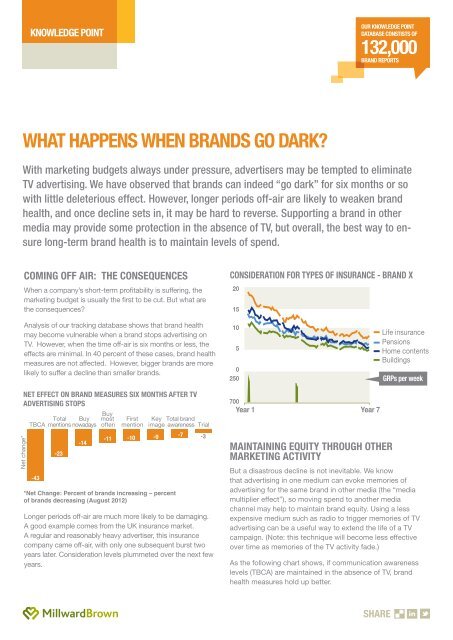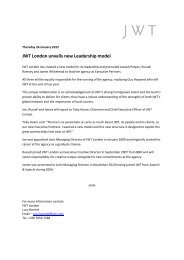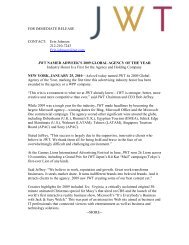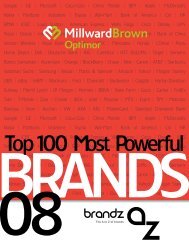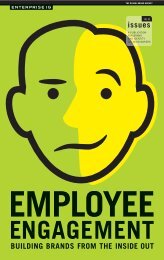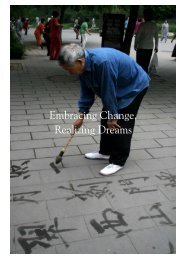WHAT HAPPENS WHEN BRANDS GO DARK? - WPP.com
WHAT HAPPENS WHEN BRANDS GO DARK? - WPP.com
WHAT HAPPENS WHEN BRANDS GO DARK? - WPP.com
- No tags were found...
Create successful ePaper yourself
Turn your PDF publications into a flip-book with our unique Google optimized e-Paper software.
KNOWLEDGE POINTOUR KNOWLEDGE POINTDATABASE CONSTISTS OF132,000BRAND REPORTS<strong>WHAT</strong> <strong>HAPPENS</strong> <strong>WHEN</strong> <strong>BRANDS</strong> <strong>GO</strong> <strong>DARK</strong>?With marketing budgets always under pressure, advertisers may be tempted to eliminateTV advertising. We have observed that brands can indeed “go dark” for six months or sowith little deleterious effect. However, longer periods off-air are likely to weaken brandhealth, and once decline sets in, it may be hard to reverse. Supporting a brand in othermedia may provide some protection in the absence of TV, but overall, the best way to ensurelong-term brand health is to maintain levels of spend.COMING OFF AIR: THE CONSEQUENCESWhen a <strong>com</strong>pany’s short-term profitability is suffering, themarketing budget is usually the first to be cut. But what arethe consequences?CONSIDERATION FOR TYPES OF INSURANCE - BRAND X2015Analysis of our tracking database shows that brand healthmay be<strong>com</strong>e vulnerable when a brand stops advertising onTV. However, when the time off-air is six months or less, theeffects are minimal. In 40 percent of these cases, brand healthmeasures are not affected. However, bigger brands are morelikely to suffer a decline than smaller brands.1050250Life insurancePensionsHome contentsBuildingsGRPs per weekNET EFFECT ON BRAND MEASURES SIX MONTHS AFTER TVADVERTISING STOPSNet change*Total BuyTBCA mentions nowadays-43-23-14BuymostoftenFirstmentionKey Total brandimage awarenessTrial-11 -10 -9 -7 -3*Net Change: Percent of brands increasing – percentof brands decreasing (August 2012)Longer periods off-air are much more likely to be damaging.A good example <strong>com</strong>es from the UK insurance market.A regular and reasonably heavy advertiser, this insurance<strong>com</strong>pany came off-air, with only one subsequent burst twoyears later. Consideration levels plummeted over the next fewyears.700Year 1Year 7MAINTAINING EQUITY THROUGH OTHERMARKETING ACTIVITYBut a disastrous decline is not inevitable. We knowthat advertising in one medium can evoke memories ofadvertising for the same brand in other media (the “mediamultiplier effect”), so moving spend to another mediachannel may help to maintain brand equity. Using a lessexpensive medium such as radio to trigger memories of TVadvertising can be a useful way to extend the life of a TVcampaign. (Note: this technique will be<strong>com</strong>e less effectiveover time as memories of the TV activity fade.)As the following chart shows, if <strong>com</strong>munication awarenesslevels (TBCA) are maintained in the absence of TV, brandhealth measures hold up better.SHARE
KNOWLEDGE POINTOUR KNOWLEDGE POINTDATABASE CONSTISTS OF70,000ADSNET EFFECT ON BRAND MEASURES SPLIT BY CHANGE IN TBCAWhen TBCA levels are maintained, other brand measures hold up betterTBCA decline-5-33Totalmentions-16-9BuynowadaysTBCA flat/increase-13Buymostoften-3-15 -15FirstmentionKeyimage38-10-12TrialTotal brandawareness4SHARE HOLDS WHILE BRAND HEALTH METRICS DECLINE1008060402039212008 season 2009 season 2010 season24% Seems tobe everywhere9% Innovative*Net Change: Percent of brands increasing – percent ofbrands decreasing (August 2012)0200720082009 2010Promotions are one way to maintain share in the absenceof TV activity. One major UK food retailer came off TV fortwo years, moving the budget into sales promotions andother below-the-line activities. Preference levels held upwell.SUPERMARKET WOULD PREFER TO SHOP ATRolling 12 weekly data4030201008000Year 1 Year 2 Year 3 Year 4Year 5Brand XGRPs per weekBrand XLikewise, a nicotine replacement treatment stopped TVadvertising for two years. The brand was able to maintainshare through increased use of promotions. Volume soldon promotion rose from 31 percent in 2008 to 53 percent in2010. However, key brand health measures declined overthis time period. So even though share may be maintainedin the short term, relying on promotion over an extendedperiod of time may not be good for a brand.Strong historical advertising memories have helped supportsome brands. An insurance <strong>com</strong>pany that had a strongBase Level of advertising awareness was able to sustain itsconsideration levels over several years — but few brandswill be in the position to be able to do this.CONSIDERATION FOR INSURANCE201510502500Year 5Year 10In the absence of TV spend, value brands are likely to maintainconsideration levels better than other brands. One leadingvalue brand stopped TV support and heavily reduced printsupport for two and a half years. TV ad awareness declined,as did spontaneous awareness, but consideration remainedconstant.HARNESSING THE “HALO EFFECT”Saving PlanInvestmentsHealthcareGRPs per weekAnother way in which brand health can be maintainedwithout advertising is by taking advantage of other relatedbrand activity.SHARE
KNOWLEDGE POINTOUR KNOWLEDGE POINTDATABASE CONSTISTS OF1,400CASE STUDIESFor example, one brand we studied came off-air for ayear, but sales actually increased. This brand was a parentbrand, and it benefited from advertising for one of itsvariants. But this benefit is not guaranteed. A review of 131case studies shows that only 23 percent demonstrated apositive “halo effect” on short-term sales.RETURNING TO AIR: THE CHALLENGE OFREVERSING DECLINEOnce equity and sales have declined, it can be hard toget them back up to previous levels. One brand cameoff-air in one region (Region B in the chart below), butcontinued advertising in the rest of the country. Within ayear, market share had dropped 2 percent in the regionwithout advertising, while holding steady elsewhere. Butin the following year, when the advertising was resumed,Region B’s market share continued to lag behind the restof the country.REGION B SUFFERS IN YEAR 2 AND YEAR 3Market shareRegion ARegion BYear 1Year 2 Year 3 %10However, some brands do recover fully after extendedperiods off-air. We’ve seen this happen when strong newexecutions, often featuring well-recognized historic brandcues, are released. But if the new advertising continues anexisting strategy, it’s crucial to ensure that the strategy is stillrelevant and ownable under the existing market conditions.One beverage brand had a very strong advertising propertybut came off-air with a break of over four years. Thenadvertising resumed with a remake of the original property.The ad achieved high impact, brand health measuresresponded, and usage increased.BUY REGULARLY/OCCASIONALLY40302010025008 YearsBrand XGRPs per week-1After considerable spend over a long period of time, oneUK finance <strong>com</strong>pany ceased advertising for over a year.As a consequence, unaided awareness and considerationdeclined. When the brand returned to air, while unaidedawareness responded, consideration did not.FINANCIAL SAVINGS - WOULD CONSIDER - SPONTANEOUS2015-2-3THE IMPORTANCE OF MAINTAINING SPENDAND SHARE OF VOICEOverall, the lesson is clear: The best way to ensure long-termbrand growth is to maintain marketing expenditure. Analysisof our tracking data has shown that a brand is most likely togain share when its share of <strong>com</strong>munication awareness isgrowing, and when it is higher than its market share:SHARE OF COMMUNICATIONS AWARENESS RELATES TOPROBABILITY OF SHARE GROWTH/DECLINEShare of <strong>com</strong>municationsawareness greater thanshare of market?105Share of <strong>com</strong>municationsawareness higher thanprevious year?02500Year 1 Year 2 Year 3Year 4Brand XGRPs per weekChances of share increase19%36%57%75%SHARE


